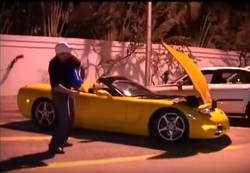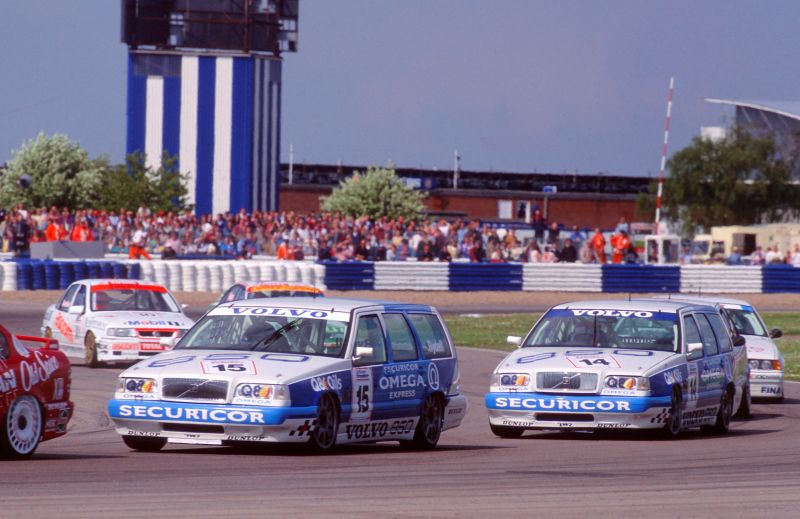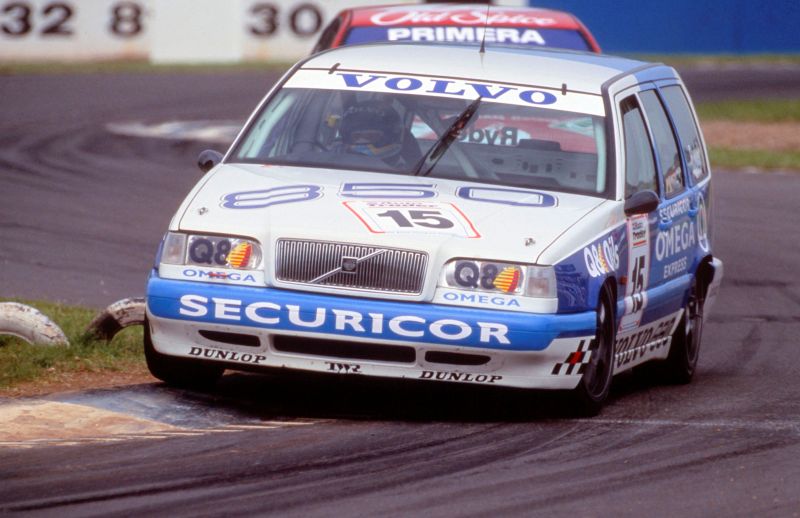
 As the old adage goes, “go big or go home.” To give you an idea of what this sandrail is all about, we don’t think that the owner will be “going home” any time in the near future. This beastly sand rail makes 1300hp. In something that weighs nothing more than an oversized go cart, that has to be an insane ride! Check out the video below with jumps and wheelies this insane ride as he shows off each and every last horsepower that the impressive rail makes! As the uploader says, the results speak for themselves!  Today, the automotive enthusiast press went into a collective tizzy over a press release sent out by the Specialty Equipment Manufacturer's Association. In it, SEMA shed light on a previously unpublicized bit of wording buried within a giant, 629-page proposal drafted by the EPA in July of 2015. "EPA Seeks to Prohibit Conversion of Vehicles Into Racecars," SEMA's headline reads. But the reality of the legislation is a lot more nuanced than that. Update, 2/9/16, 5:45PM: See the end of this post for further clarification from the EPA. EPA spokeswoman Laura Allen released the following statement on the recently uncovered EPA language: People may use EPA-certified motor vehicles for competition, but to protect public health from air pollution, the Clean Air Act has – since its inception – specifically prohibited tampering with or defeating the emission control systems on those vehicles.The proposed regulation that SEMA has commented on does not change this long-standing law, or approach. Instead, the proposed language in the Heavy-Duty Greenhouse Gas rulemaking simply clarifies the distinction between motor vehicles and nonroad vehicles such as dirt bikes and snowmobiles. Unlike motor vehicles – which include cars, light trucks, and highway motorcycles – nonroad vehicles may, under certain circumstances, be modified for use in competitive events in ways that would otherwise be prohibited by the Clean Air Act. EPA is now reviewing public comments on this proposal. In other words, the wording included in the bill, and highlighted by SEMA, is not a newly established rule outlawing a previously allowed activity. Instead, with this language, the EPA seeks only to clarify the wording of an existing law—one that has been in place for many years, and that apparently has not hampered our current culture of amateur or semi-professional competition using production road vehicles in any way. What isn't clear is how the EPA's newly clarified language will affect hobby racers going forward. The draft, as far as we've seen, does not include any proposal for enforcement. The law is not slated to go into effect until 2018, and it won't be retroactive. So even if it does pass as currently written, it will never apply to current racing-modified production cars, only to those produced in 2018 or later and purchased with the intent of being raced. That is, if the law passes at all. We applaud SEMA for bringing this issue to light. Were it not for the organization's diligent analysis of vehicular legislation, none of us would even know about this issue—the EPA proposal was drafted in July 2015, and the public comment period opened and closed with no major coverage. SEMA has been pursuing the issue ever since, submitting comments on the original draft proposal and meeting with EPA agents to discuss the ramifications. But as it stands right now, we don't know enough about the EPA's proposal to make broad-reaching conclusions about what it means for current or future racers. Currently, it's illegal under federal law to remove the emissions-controls devices from any car sold to be driven on the street, a fact that was true long before the EPA wrote this proposal. When was the last time you saw a track day, LeMons race, hillclimb, drag-strip meetup, or any other amateur racing event broken up by Feds? R&T has reached out to the EPA for clarification on the law, the plans for enforcement, and what types of vehicles or competition might be exempted. Until then, let's not race to conclusions. Update: EPA spokesperson Laura Allen provided this further clarification to R&T: This clarification does not affect EPA's enforcement authority. It is still illegal to tamper with or defeat the emission control systems of motor vehicles. In the course of selecting cases for enforcement, the EPA has and will continue to consider whether the tampered vehicle is used exclusively for competition. The EPA remains primarily concerned with cases where the tampered vehicle is used on public roads, and more specifically with aftermarket manufacturers who sell devices that defeat emission control systems on vehicles used on public roads. Emphasis added. From this, it sure sounds like (as we stated above) the EPA doesn't plan on confiscating your trailered, track-only race vehicle—only that, as has been the case since emissions regulation began, you're breaking the law if you remove federally-mandated emissions controls from your street-driven car.  Twenty years have passed since Volvo entered two 850 wagons in the British Touring Car Championship. To this day it is still one of the bravest, nuttiest, and awesome cars. Why? Because racing wagon. In 1993, Volvo joined forces with Tom Walkinshaw Racing, the team that had been their main competitor in the European Championship series during the 1980s when the 240 Turbo was competing against the Rover SD1. The contract was signed for three years and the decision was made early on to use wagons, but nobody outside the garage knew about that until the very last second, including their drivers Rickard Rydell and Jan Lammers. Rydell had this to say about the experience: When I signed up for Volvo and TWR around Christmas 1993, I didn't know about the estate plans. If I'd known, I would probably have hesitated, so it was lucky I didn't know! We hadn't had time to test the car on the track before its launch at Thruxton on 4 April. Jan Lammers and I had been able to drive a few hundred meters at the entrance to TWR's development workshop, but that was all! The Volvo 850 estate was by far the largest car in the series. Our competitors, who were taking part largely to strengthen their sporting image, were not pleased about having to compete with an estate. There were a few taunts from other drivers – but that was no problem. To wind them up, in one heat we drove with a large stuffed collie in the boot during the parade lap! While aerodynamically superior to the saloon, a large estate is not an ideal track car due to having a lot of weight behind the rear axle and a higher centre of gravity, but Volvo wanted to get as much attention as possible, and with two wheels in the air in most corners, success was guaranteed. The racing 850s used a five-cylinder naturally aspirated 2-liter engine producing around 290 hp that went through a six-speed sequential transmission instead of the standard 2.3 turbo's five-speed manual. They also had catalytic converter which only become mandatory later on. Rickard Rydell came in third place overall in 1995 and 1996, driving sedans. The 850 wagon only got the first season to prove itself because the 1995 introduction of an additional spoiler at the rear had no benefit on a wagon. The 850's racing career ended in 1997 when Volvo changed to the S40, winning the entire series in 1998. Still, the one everybody remembers is the 1994 car...  Like a boss, lol. Scandalous Racing rents a vette in Florida, adds nitrous to it and runs a few locals for money. Watch the video below. Pretty funny! This video of a Lamborghini Aventador on a dyno may be the greatest thing you will hear all week2/9/2016
 Washington, DC (February 8, 2016) – The U.S. Environmental Protection Agency (EPA) has proposed a regulation to prohibit conversion of vehicles originally designed for on-road use into racecars. The regulation would also make the sale of certain products for use on such vehicles illegal. The proposed regulation was contained within a non-related proposed regulation entitled "Greenhouse Gas Emissions and Fuel Efficiency Standards for Medium- and Heavy-Duty Engines and Vehicles—Phase 2. The regulation would impact all vehicle types, including the sports cars, sedans and hatch-backs commonly converted strictly for use at the track. While the Clean Air Act prohibits certain modifications to motor vehicles, it is clear that vehicles built or modified for racing, and not used on the streets, are not the "motor vehicles" that Congress intended to regulate. "This proposed regulation represents overreaching by the agency, runs contrary to the law and defies decades of racing activity where EPA has acknowledged and allowed conversion of vehicles," said SEMA President and CEO Chris Kersting. "Congress did not intend the original Clean Air Act to extend to vehicles modified for racing and has re-enforced that intent on more than one occasion." SEMA submitted comments in opposition to the regulation and met with the EPA to confirm the agency’s intentions. The EPA indicated that the regulation would prohibit conversion of vehicles into racecars and make the sale of certain emissions-related parts for use on converted vehicles illegal. Working with other affected organizations, including those representing legions of professional and hobbyist racers and fans, SEMA will continue to oppose the regulation through the administrative process and will seek congressional support and judicial intervention as necessary. The EPA has indicated it expects to publish final regulations by July 2016."  We should’ve seen this coming. Considering the Jimmy Fallon-like viewing numbers the Tax The Rich guys are racking up on YouTubehooning multi-million-dollar supercars, it was only a matter of time before the knockoffs started coming out of the woodwork. Still, it takes a special kind of chutzpah to haul your Lamborghini Gallardo LP 570-4 Performante Spyder—currently worth around $210,000— to the Bonneville Salt Flats, then whip off some donuts while axle-deep in the shallow lake that forms on top of the salty plain during winter. Obviously, we’re all in favor of supercar owners taking six-figure speed machines out and driving them the way they were intended to be driven, even in the dead of winter. (One of many reasons to love Jon Olsson.) But there’s a difference between not coddling your car and driving it balls-deep through salt water. Also: messing with history. The U.S. Bureau of Land Management, which manages Bonneville, designated the Salt Flats as an area of Critical Environmental Concern in 1985. During the past 60 years, millions of tons of salt have been transferred from the racing area to Intrepid Potash, a nearby mining operation. While Intrepid has recently pumped salt brine back into the flats, it hasn’t been enough to replace the 50-75 million tons evacuated prior to 1997. The International Track, once thirteen miles, now measures only eight. Save Indianapolis and Daytona, Bonneville might be the greatest surviving American historic speed venue. We’re all about hooning, but trashing the Salt Flats is decidedly uncool. Good idea. Poor execution.  Nick Mason (yes, we're talking about Pink Floyd's drummer, not your neighbor who happens to have the same name) is the kind of man who invests a great deal of his fortune into his automotive passion. As a result, it comes as no surprise that the legend's car collection includes a LaFerrari. What might surprise certain people, though, is the fact that, at age 72, Nick keeps learning. The most recent example of this saw him handing over the keys to his LaF to racing driver Emanuele Pirro. Not only did the five-time LeMans champion get to flog the 950 hp (963 PS) hybrid, obviously on a track, but the drummer was riding shotgun at the time. With the Prancing Horse's tail-happy rear-wheel-drive setup and the typical British weather, it's safe to say the two had quite an experience in the LaF. The only unfortunate side of it all is that the clip below is short, so we don't get the full taste of the memorable track stint that certainly taught Nick a thing or two about the limits of his machine. The feat didn't happen by mistake, as today, January 27, happens to be Nick's birthday and the resulting footage was released by Goodwood Road and Racing as a celebration. What can we say? This certainly beats a Ferrari-shaped cake. As for the Emanuele Pirro-related side of the story, it's nice to see this champion enjoying his time in a Ferrari halo car. This is quite a change from all the times we saw the man taking home the Le Mans title in Audis - he won the LMP900 class three times in an R8, as well as the top-tier LMP1 Class twice, behind the wheel of a diesel-hearted Audi R10 TDI. This story brings us to the rumor mill talk about Ferrari returning to the LMP1 hostilities, but this is another story for another time.  We have been having a rough time finding an affordable office/shop combo. Our current office is great, but without a place to wrench on cars we are limited. Well, We found the perfect solution for us! It a Ferrari F1 race trailer… garage… office… Wow, whatever this thing is, it is awesome! Just take a look inside and you will see what I mean. It’s listed here on Motorsport Auctions for €199,000 EUR so it’s unfortunately out of the budget. I suppose we could save on monthly rent by just moving around to a different parking lot everyday though…  We all know that automotive story from the 1960s, the story of how Henry Ford II showed Enzo Ferrari who’s top dog at Le Mans. It’s the story of the world-beating Ford GT40, a car so rare and valuable that us mortals can only dream of owning one. The GT40 Registry-eligible replica you can admire above is more attainable than the original endurance racer. Priced from $169,995, the 50th Anniversary Shelby GT40 celebrates the legendary 1-2-3 sweep at the 1966 edition of the 24 Hours of Le Mans race. The thing is, though, that mountain of green dollar bills doesn’t buy you an engine or a transmission. According to Shelby American, the best combo you could get on their iteration of the GT40 is a classically correct manual transmission and no less than 427 cubic inches (7 liters) of Ford FE V8 madness. The least expensive 427 FE goes for $27,499.99, which is Chevrolet Impala money. But then again, the 427’s rumble makes it worth it. The anniversary GT40 stays true to the original GT40 Mk II’s dimensions. In plain English, that’s 163 inches (4.14 meters) long and 40 inches (1.01 meters) high. For the taller ones among us, Shelby American will gladly install a Gurney bubble right over the driver’s seat. Even the 2x10-gallon fuel tanks and the Halibrand style pin drive wheels are made to the old GT40’s specifications. If you aren’t too fond of the black and silver color scheme of Bruce McLaren’s 1966 winning machine, Shelby American can paint your anniversary GT40 in blue or red, with or without the white racing stripes. For those of you who can’t do without the cool blow of air conditioning, fret not because the right price will get you that as well. With these being said, forgo the balloons and party poppers - just put your money where your mouth is and buckle up because driving this bruiser is what celebrating Le Mans is all about. |
///Categories
All
Archives
January 2024
|



 RSS Feed
RSS Feed